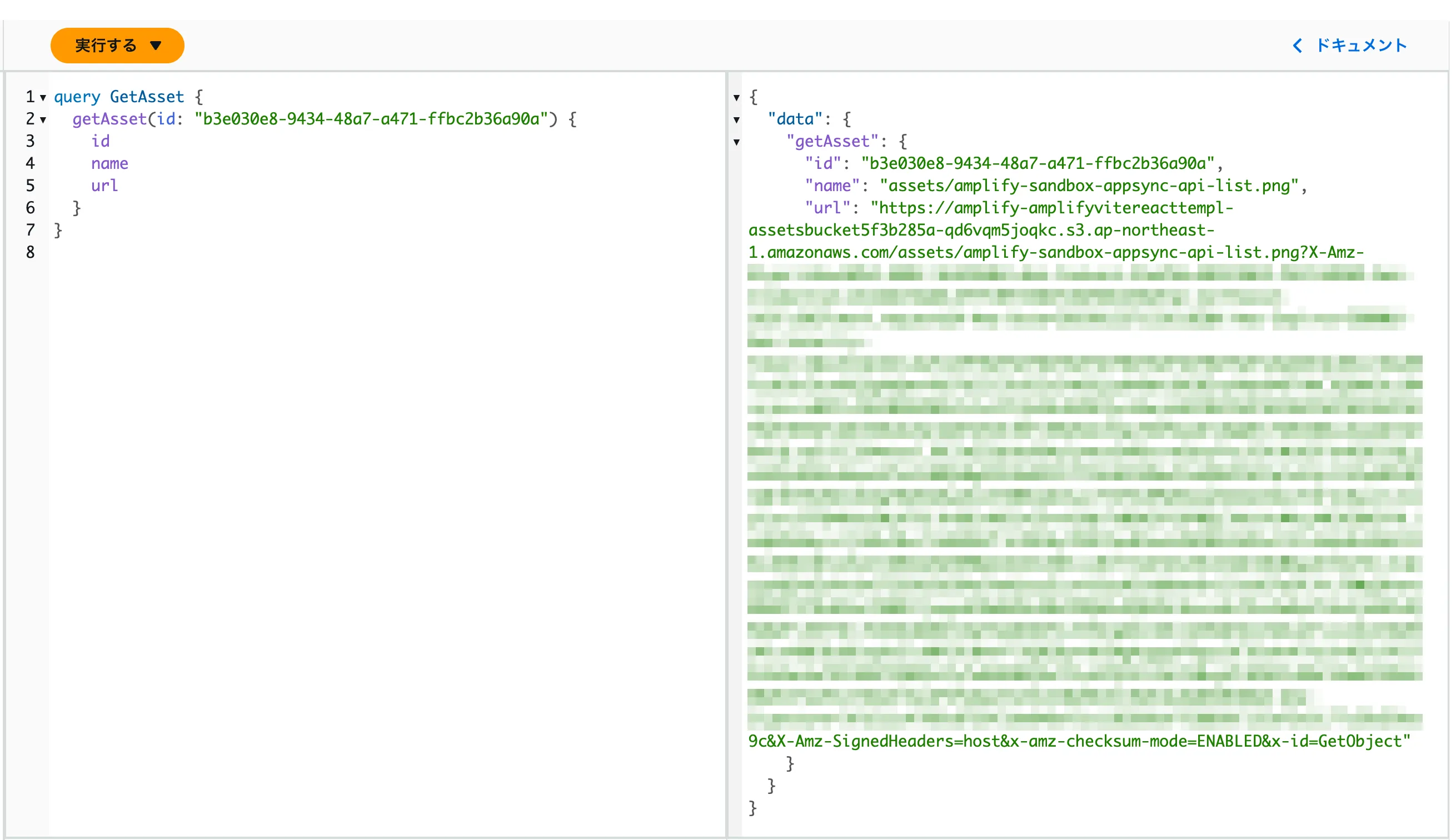Amplify Gen2 でフィールドレベルのリゾルバーとして Lambda リゾルバーを追加する
Amplify Gen2 でフィールドレベルのリゾルバーとして Lambda リゾルバーを追加する方法を紹介します。
Amplify Gen1 の場合
Amplify Gen1 の頃は以下のように簡単にフィールドレベルのリゾルバーとして Lambda リゾルバーを追加することができました。
type Asset @model {
#
# S3 Key of this asset
#
name: String!
#
# Type of this asset
#
type: String!
#
# Download URL for this asset
#
url: AWSURL! @function("assetUrl")
}このように@functionディレクティブをurlフィールドに指定すると、urlフィールドを解決するリゾルバーとしてassertUrlという Lambda が呼び出されるようになります。
Amplify Gen2 の場合
これを、Amplify Gen2 の TypeScript を用いたスキーマ定義で書こうとすると以下のようなイメージです。 しかし、Amplify Gen2 でフィールドレベルのリゾルバーを追加する方法が提供されていません。 モデルのフィールドにカスタムリゾルバーを追加するための API が用意されていないからです。
import { a, defineData, defineFunction } from "@aws-amplify/backend";
const assetUrlHandler = defineFunction({
entry: "./assetUrl-handler/handler.ts",
});
const schema = a.schema({
Asset: a
.model({
name: a.string(),
type: a.string(),
// 実際には a.url().handler(...) のようなAPIはないので、このようには書けない
url: a.url().handler(a.handler.function(assetUrlHandler)),
})
.authorization((allow) => [allow.publicApiKey()]),
});上記のように、a.url().handler(...)のような記述でフィールドレベルに Lambda リゾルバーを設定することはできませんが、Amplify Gen2 は AWS CDK ベースなので、
次に紹介するように AWS CDK の API を利用して設定することが可能です。
Step 1: ハンドラーとなる Lambda を実装する
最初に、フィールドレベルの Lambda ハンドラーを以下のように実装します。 以下のコードは S3 の署名付き URL を発行して、その URL を返す Lambda です。
Asset.urlのリゾルバーからこの Lambda のhandler関数が呼び出されます。その時に引数でeventを受け取ります。
event.sourceを通してAssetのフォールドを取得できます(この後の Step でその設定をします)。
例えばAsset.nameを取得する場合はevent.source.nameで取得できます。
amplify/function/assetUrl.ts:
import type { AppSyncResolverHandler } from "aws-lambda";
import { getSignedUrl } from "@aws-sdk/s3-request-presigner";
import {
S3Client,
GetObjectCommand,
GetObjectCommandInput,
} from "@aws-sdk/client-s3";
import { env } from "$amplify/env/asset-url";
export const handler: AppSyncResolverHandler<unknown, string> = async (
event,
context
) => {
if (!event.source) {
throw new Error("Event source is not found.");
}
const client = new S3Client({
region: env.AWS_REGION,
});
const params: GetObjectCommandInput = {
Bucket: env.ASSETS_BUCKET_NAME,
Key: event.source.name, // Asset.nameからS3のキーを取得
};
const command = new GetObjectCommand(params);
return await getSignedUrl(client, command, { expiresIn: 3600 });
};Lambda のコードが作成できたらdefineFunctionで Lambda 関数を定義します。
amplify/function/resource.ts:
import { defineFunction } from "@aws-amplify/backend";
const assetUrlHandler = defineFunction({
entry: "./assetUrl.ts",
});Step 2: AppSync のリゾルバーを設定する
クエリーでAsset.urlが指定された場合、上記の Lambda が呼び出されその値が解決されるようにします。
最初に、先ほど作成した Lambda を AppSnc のデータソースとして追加します。
次に、データソースとなる Lambda を呼び出す AppSync 関数を作成ます。
最後に、Asset.urlのリゾルバーを追加し、上記の AppSync 関数を設定します。
amplify/backend.ts:
import { defineBackend } from "@aws-amplify/backend";
import type { AmplifyGraphqlApi } from "@aws-amplify/graphql-api-construct";
import { auth } from "./auth/resource";
import { data } from "./data/resource";
import { assetUrl } from "./function/resource";
import * as lambda from "aws-cdk-lib/aws-lambda";
import * as appsync from "aws-cdk-lib/aws-appsync";
const backend = defineBackend({
auth,
data,
assetUrl,
});
// 1. Lambdaデータソースを追加
const dataSource = backend.data.addLambdaDataSource(
"AssetUrlDataSource",
backend.assetUrl.resources.lambda,
{}
);
// 2. リゾルバーが呼び出す関数を追加
const appsyncFunction = backend.data.addFunction("AssetUrlFunction", {
dataSource,
name: "AssetUrlFunction",
runtime: appsync.FunctionRuntime.JS_1_0_0,
code: appsync.AssetCode.fromInline(`
export function request(ctx) {
return {
operation: 'Invoke',
payload: {
typeName: 'Asset',
field: 'url',
arguments: ctx.args,
identity: ctx.identity,
source: ctx.source,
request: ctx.request,
prev: ctx.prev,
},
invocationType: "RequestResponse"
};
}
export function response(ctx) {
return ctx.result
}
`),
});
// 3. リゾルバを追加
const resolver = backend.data.addResolver("AssetUrlResolver", {
fieldName: "url",
typeName: "Asset",
pipelineConfig: [appsyncFunction],
runtime: appsync.FunctionRuntime.JS_1_0_0,
code: appsync.AssetCode.fromInline(`
export function request(ctx) {
return {};
}
export function response(ctx) {
if (ctx.error) {
util.error(ctx.error.message, ctx.error.type);
}
return ctx.prev.result;
}
`),
});以上でAsset.urlフィールドに Lmabda リゾルバーを設定できました。
デプロイ&動作確認
AWS コンソールから以下のような AppSync のクエリを実行してみます。
urlフィールドで発行された署名付き URL が取得できていることが確認できます。

ここで紹介したコードはGitHub のリポジトリでも公開しています。参考にしてください。